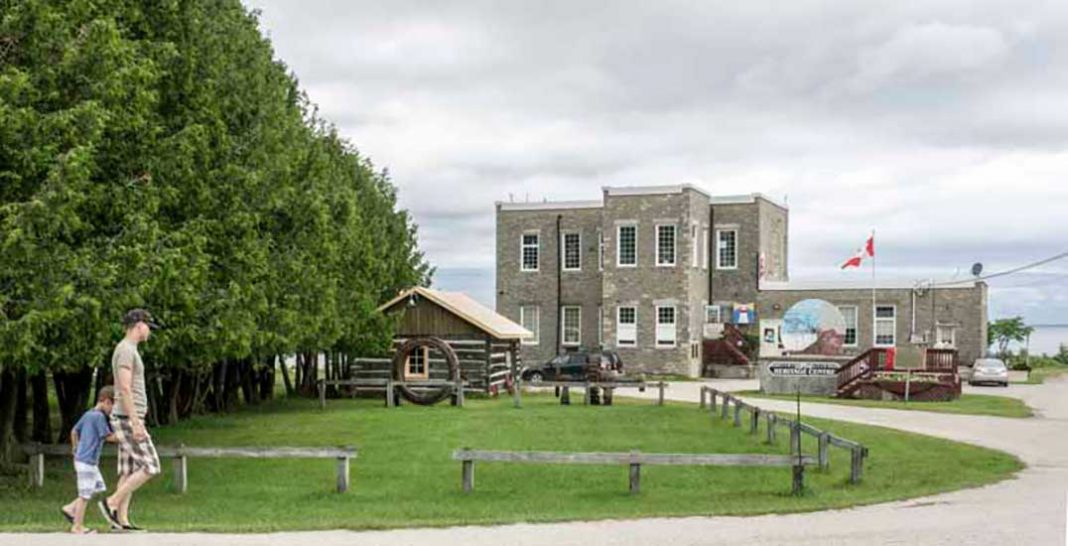KAGAWONG – Billings council has voted in favour of mould abatement and renovations at the municipal office located within the Old Mill Heritage Centre. At a special meeting on January 6, a community delegation represented by Sandy Cook asked council to consider instead that the building be remediated and renovated into a three-season arts-and-culture-only building containing an enlarged museum space as well as the existing art studio and shop. The council noted, however, that the planned work was necessary to alleviate health and safety issues for municipal staff and other visitors to the building for current and any future uses.
Ms. Cook acknowledged council’s good intentions with plans to remediate problems but noted the alternate proposal upheld principles included in the township’s Adopt Asset Management Policy Bylaw 2019-24 which states, “We are committed to delivering services in a socially, economically and environmentally responsible manner. We will consider stakeholder wants, needs and priorities and commit to having an informed understanding of the trade-offs between risks, costs and service performance.”
“Something needs to be done,” she said, “but that doesn’t mean trying to put it back the way it was,” noting the alternate proposal addressed these service priorities.
“The Old Mill Heritage Centre is a successful and vital component of the Billings cultural scene,” said Ms. Cook, not only drawing hundreds of people to annual events and ambitious exhibits but also volunteers and fundraisers. She explained the current museum space presents an “obstacle to bringing these exhibits and badly needs updating to accommodate the rigorous requirements of hosting precious collections.” A beautiful new space would be “a point of pride for the whole community” that preserves an iconic heritage building, she added.
There is funding available that can maximize taxpayer dollars if the Old Mill is solely an arts and museum space, Ms. Cook told council. Through the Canadian Cultural Spaces Fund (CCSF) the township would be eligible to receive up to 50 percent for exterior or interior renovations and accessibility and includes planning, architect and engineering fees. As a building located in a rural and remote area there is a potential for up to 75 percent project funding.
Additional federal funding could be available through the Federation of Canadian Municipalities, which has funds for up to 50 percent of costs for planning and feasibility studies as well as available capital grants and low interest loans. This funding is “stackable,” meaning FCM funding is eligible on top of CCSF funds or other federal/provincial funding. “We are talking about getting $3 of funding for every taxpayer dollar.”
She estimated the current renovation work would incur total expenses of $400,000 to $460,000 for “band-aid measures” that “do not address the long term sustainability of the building” and suggested that “by applying for federal funding for a three season building used as a cultural space, $400,000 of taxpayer money can buy the township $800,000 to $1,200,000 worth of work.”
According to Ms. Cook, economic benefits from this proposal include: more money available for work could provide more or longer employment; the ability to host more ambitious museum projects that would bring more visitors and economic benefits to the community; a clear plan generating enthusiasm and support for fundraising events to raise extra funds that could ease the tax burden; and enhancement of a significant landmark that attracts visitors and businesses to Kagawong’s waterfront.
Ms. Cook also said the three season plan would promote significant greenhouse gas reduction and cost savings from reduced propane use for heating and the carbon tax associated with using propane. “It is the kind of radical reduction that funders love to see,” she said.
The necessary removal of contaminated material surrounding the Old Mill may also be eligible for funding, she noted.
“The Old Mill is an iconic heritage building and the centre of present and future cultural space,” she concluded. “The township and community members can make gains socially, economically and environmentally by pressing the pause button. Pausing the tender process and stepping back to look anew at our beloved asset that is in critical condition can help us move forward with an innovative solution that makes real headway on our environmental and infrastructure goals.”
“Rather than choose which company will build an overpriced cube, will council take steps to be consistent with their asset management policy, seize the opportunity and plan for a sustainable future for the Old Mill and the Township of Billings,” she asked.
Mayor Ian Anderson thanked Ms. Cook for her presentation and acknowledged the time and dedication required to research the proposal before explaining how council makes decisions and considerations in municipal funding.
This current council pledged to responsible use of taxpayer dollars and to better communicate rationale for decision making. Decisions are based on many factors, noted Mayor Anderson, including legislation, public and staff safety, affordability, public and staff input and the township’s strategic plan. He provided a brief history of the issue followed by a description of planned remediation work.
While the Old Mill is clearly an important part of Kagawong heritage, “it is not formally designated as a heritage building and the office configuration has essentially remained the same since inception,” the mayor said. Originally built as a pulp mill circa 1925, the Old Mill then operated as a hydro generating station from 1946 to 1961. It was used by HEPC/Ontario Hydro as a stores facility until 1983 when ownership shifted to Billings. The municipal office space was first renovated for use in the 1980s and has been occupied by the township as the municipal office since approximately 1999.
Council began an investigation after municipal staff first questioned air quality in mid-2018. Air quality was tested in September 2018. Further testing revealed mould spores and VOCs (volatile organic compounds). An HRV system was installed during the winter of 2019 to improve air quality but this did not address the source. Staff returned to the offices at the Old Mill in spring 2019 but by October 2019 had to return to temporary facilities in the Park Centre.
Tulloch Engineering was engaged to define the scope of remediation work and a request for tenders was issued. Source remediation work was required before the space could be occupied as an office, said Mayor Anderson. “All the work is being carried out to address health and safety concerns and is required regardless of who uses this space, now and in the future.” He noted the completed work will provide an opportunity to make significant improvements to the energy efficiency of the municipal office.
Bids were considered at its December 20 meeting. The two received bids were higher than expected and a decision was deferred so the engineer could consult with bidders and clarify components of the work and cost.
The work addresses the main source of contamination and will include demolition and removals of flooring in the east end of the office including floor covering, sub-floor and floor joists; removal of carpeting in main office; the installation of a reinforced sealed concrete floor in the east office space; smoothing and sealing of the existing concrete floor in the main office; installation of commercial floor tiles; reinstallation of the washroom and electrical, telephone and data lines as needed, the installation of insulation and drywall, and painting. Removal of non-load-bearing interior walls will create a little additional space, attendees were told.
Expenditures, including completion of the remediation work, HRV system, engineering costs and soil contamination monitoring wells total $265,799.
The challenges of municipal asset management and funding for infrastructure projects such as roads, buildings, water, etc. is greater for smaller municipalities because of limited options for generating revenue dollars other than tax dollars, explained Mayor Anderson. “The township does have an asset management policy and is engaged in planning. The implementation of long term planning is important for responsible management and is much more challenging than it appears.”
Asset management is influenced by many things, including building condition assessment reports, ongoing assessment of township conditions and needs and the Municipal Climate Change Action Plan. “Asset management is focused on both long-term and is operation wide but sometimes, conditions demand immediate action,” said the mayor.
A chart was provided that showed existing committed and planned projects that will be completed over the next few years. These are: Kagawong Waterfront Development; Main Street hill: engineering and partial reconstruction; washrooms/shoreline erosion control and boardwalk; Old Mill Road waterline; municipal office soil contaminant remediation; Park Centre generator; public works vehicles; and bridge replacements at Old Mill Road and Mud Creek Road. These projects have a known or estimated cost of approximately $9,210,320 with the known municipal portion at more than $1,323,000. Other projects, such as the fire hall renovation and mould remediation and a used tanker for the fire department, do not have known costs at this time.
“There is a staggering amount committed,” said Mayor Anderson. “The luxury of having money to freely spend doesn’t exist. There is not a limitless supply.” He noted that each one percent increase in the property tax rate generates about $18,000 for the township. “So to raise $180,000 for our part of a project it would require A 10 percent increase in the property tax rate.”
He also noted there are staff costs associated with applying for and administering any given project.
Council considered the two bids received for the work on the municipal office, being $179,850 from First General Services in Little Current and $189,999 from Rob Seifried Construction of Kagawong. The motion to hire Rob Seifried Construction to undertake the Old Mill remediation work for $189,999 was passed unanimously.





